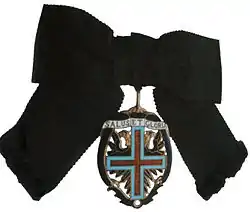Order of Elizabeth
The Imperial Austrian Order of Elizabeth (German: Kaiserlich österreichischer Elizabeth-Orden), founded in 1898 by Francis Joseph, Emperor of Austria and King of Hungary, was an order created for women. The order was the namesake of Saint Elisabeth of Hungary, but it was created to honor and memorialize Franz Joseph's late wife, Empress-Queen Elisabeth.
| Imperial Order of Elizabeth | |
|---|---|
 3rd Class of the Order | |
| Awarded by the head of the House of Habsburg | |
| Type | Order of chivalry for women |
| Established | 17 September 1898 1898 - 1918 (National Order) 1918 - present (Dynastic Order) 17 November (Feast day) |
| Royal house | House of Habsburg |
| Religious affiliation | Roman Catholic |
| Awarded for | General welfare in Religious, Charitable or Philanthropic Merit |
| Status | Dormant Order since 2010 |
| Sovereign | Crown Prince Karl of Austria |
| Grades |
|
| Statistics | |
| First induction | 1898: Countess Irma Sztáray de Sztára et Nagymihály |
| Last induction | 1951: Princess Regina of Saxe-Meiningen |
| Total inductees | 1121 |
| Precedence | |
| Next (higher) | Order of Leopold |
| Next (lower) | Order of Franz Joseph |
| Equivalent | Order of the Iron Crown |
Ribbon of the Order | |
The order, which only existed until the end of the monarchy in 1918, was divided into three classes: Grand Cross, first and second classes. There was also an Elizabeth Medal for civil merit.
Significance of Saint Elizabeth
Saint Elisabeth (1207–1231) was a Hungarian princess, the daughter of King Andrew II of Hungary.[1] Married at age thirteen to Louis IV, Landgrave of Thuringia (ca. 1220), she spent her life giving alms to the poor and sick. After her husband's death, she gave away the vast majority of his estate to build hospitals and to aid in the relief of her starving subjects. After dying of natural causes in 1231, she was canonized by Pope Gregory IX, in 1235. She is considered the patron saint of bakers, beggars, and charities. Given her status as Hungarian royalty, her patronage of charities, and the fact that the Holy Relics attributed to her resided in Vienna, Saint Elizabeth made for a perfect choice for the award's name.
Empress Elizabeth "Sisi"
Née Duchess Elisabeth in Bavaria (1837–1898), "Sisi" was a cousin of King Ludwig II of Bavaria. She married the 24-year-old Emperor Francis Joseph in 1854. Despite a cold start to their marriage, the two eventually reconciled, and fell in love. Theirs was a classic, mid-19th century, courtly relationship, where occasional infidelity by one or both parties was discreetly accepted. They were, for the most part, "happy" by the standards of the day, and were married for over 44 years. When Elisabeth was assassinated in 1898, the widowed emperor was devastated by the loss. Creating the Order of Elisabeth was as much a public show of affection as his memorial to her as it was to honor Saint Elisabeth.
The Order
According to medal expert and collector Yuri Yashnev:[2]
The award was intended for ladies, regardless of social status or religion, for merits in religious and charitable work. The award had four degrees - the Grand Cross, I Degree and II Degree, and also a cross of merit... Awards were made, personally, by the emperor... the badges and insignia of the Order were to be returned to the state upon the death of the member, or upon the advancement from a lower degree to a higher degree... There were 81 awards of the Grand Cross, 332 awards of the I Degree, 500 awards of the II Degree, and 208 awards of the Elizabeth Medal for merit, between 1898 and 1918, when the Order was disbanded with the collapse of the monarchy.
Recipients
Sources
- The Catholic Encyclopedia. "St. Elizabeth of Hungary". 1909, On the Internet: http://www.newadvent.org/cathen/05389a.htm
- Yashnev, Yuri (2003). Orders and Medals of the Austro-Hungarian Empire. Archived from the original on 2 April 2009.

